
By Staff
April 28th, 2020
BURLINGTON, ON
The summer is beginning to look quite quiet; the Burlington Downtown Car Show has been cancelled.
 Remembering when Ron Baker, organizer and promoter of the event announced today that “Due to the Covid-19 pandemic and the uncertainty of protocol for social distancing in early July, the Burlington Downtown Car Show is cancelled for this year.
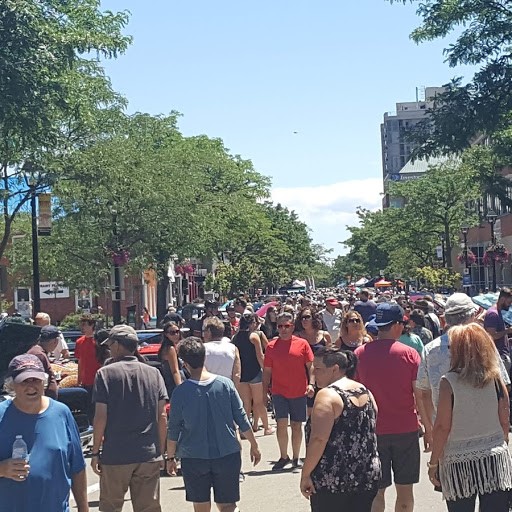 Best argument ever for making Brant a pedestrian only street – car show crowd filled the street ‘The Car Show has become a mainstay of summer in the city. Five hundred meters of Brant Street in downtown Burlington is turned into a pedestrian mall with as many as 200 cars on display.
“The idea has always been to present a celebration of the automobile”, stated Ron Baker, car show founder. “We have had representation of every decade of the automobile on display, from 1910 to present day”. The show has attracted over 100,000 visitors in the past five years.
The summer of 2021 is an option.

 By Nicki St George By Nicki St George
April 28th, 2020
BURLINGTON, ON
Nicki St George is the mother of two, lives in Aldershot and teaches at a private school in Oakville. She is also a recovering cancer patient.
WEEK 6 – seriously?
As the days are becoming indistinguishable from one another, here are some ups and downs during my time in self-isolation:
The UPS:
• When a box is delivered, and you cannot remember what it could be because you have ordered so much crap over the last 6 weeks.
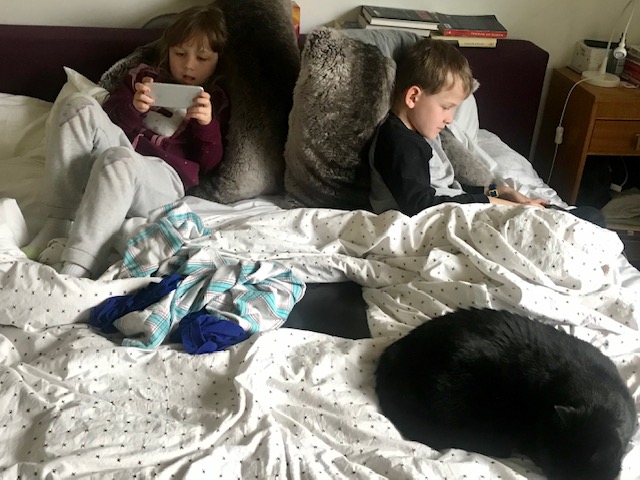 Clifford the cat and the kids – in their parents bed. • Clifford the cat – my self-isolation guru.
• When the makers of Candy Crush give the gift of unlimited lives for a whole week!
• Having the time to make homemade hamburger buns and other treats.
• Puzzles – Now that everyone is into doing puzzles, I do not feel like quite as big a nerd.
• No sport on TV = nothing left for my husband and I to fight about.
• Learning a new language while binge watching Money Heist.
• Saying goodbye on Zoom or Houseparty…you just hang up! No more awkward goodbyes at the door.
• Saving money on car insurance because you are no longer driving to work every day.
• Bringing out the patio furniture and setting up the trampoline. It’s starting to feel a little like summer.
• Less laundry…just choose your legging/sweat top combo for the week and you’re good to go.
• The magical hour around 5pm every day when a glass of wine and favourite song provide me with the motivation to dance and cook dinner.
• Discovering a new podcast.
The DOWNS:
• Temperatures in the single digits in April…or worse, snow!
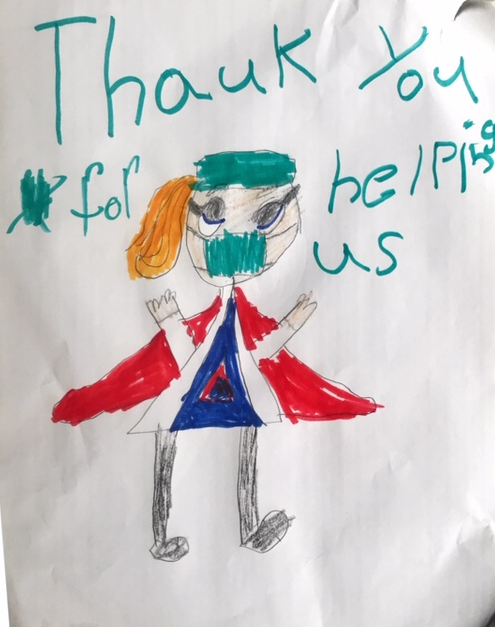 Results of a parent led art class • The annoying soundtrack of Beatrix’s YouTube videos which have become ambient noise in the house.
• My embarrassingly high score on Candy Crush.
• Where do all the charging cables keep disappearing to?
• Making plans for the summer…
• Google classroom on the iPad: why can’t I just write on the document?
• Sad husband because there is no sport on TV.
• Finding out that schools will remain closed until at least May 31st – SERENITY NOW!
• Doing your tax return – the worst part of being an adult.
• Getting the weekly alert telling me what the average daily screen time was last week…gulp.
• The absurd volume of new passwords to remember for accessing homeschool websites.
• Deciding what PPE to don on the weekly trip to the grocery store – how many times can I reuse this same mask?
• At home haircuts…they’re not everyone’s cup of tea.
• Finding the motivation to do at home workouts and complete assignments for grad school.
• Being interrupted by children asking for TV during a work Zoom call -this was not on the list of pre-approved activities.
• Google Play charging $19.95 to RENT Trolls 2 – how dare they?
• Discarded latex gloves left on the ground: so uncool.
Previous columns:
The idea
Week 1
Week 2
Week 3
Week 5

 By Staff By Staff
April 27th, 2020
BURLINGTON, ON
In her A Better Burlington newsletter, Mayor Marianne Meed Ward said:
Our community has received some great and long awaited news today from Steve Clark, Minister of Municipal Affairs and Housing, and Caroline Mulroney, Minister of Transportation: the city and Region can immediately work together to remove the Major Transit Station Area (MTSA) and Mobility Hub designations downtown.
These designations have been used to justify overdevelopment in downtown Burlington.
In a letter addressed to myself as head of Burlington City Council and Gary Carr, Chair of Halton Region Council, the Minister states:
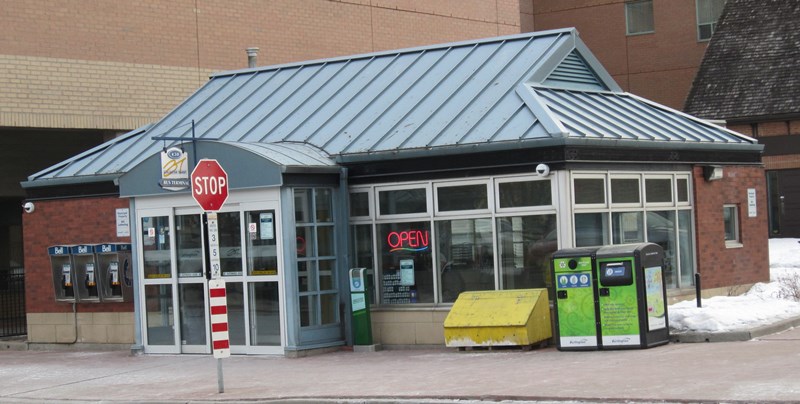 There was a point at which a former Director of Transit suggested tearing the building down. Then it became a technical point on which a developer won the right to put up a 24 story building. “There is no provincial requirement for mobility hubs to be identified in municipal official plans, including Downtown Burlington…. Therefore, the Region of Halton, working with the City of Burlington, has the ability to remove the identification of a mobility hub and an MTSA in Downtown Burlington, centred on the John Street bus terminal, from its Official Plan.”
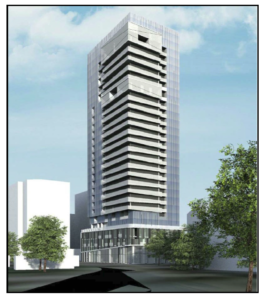 The developers of the Naurique will always have a soft spot for that little transit station. The letter further states that the change can be made through an Official Plan Amendment now, or during the next Municipal Comprehensive Review, scheduled at the Region for later this year.
“This means that the Region can submit an amendment to remove the Downtown Burlington mobility hub and MTSA designations in the Region of Halton’s Official Plan now.”
The mobility hub designation for downtown Burlington and the Burlington GO station first appeared in Metrolinx documents in 2008, and was later embedded into the Region of Halton Official Plan in 2011, based on the 2008 Regional Transportation Plan.
The 2041 Regional Transportation Plan, issued in 2018, refined the concept of mobility hubs to focus on MTSAs along subway lines and priority transit corridors.
As a result of changes to the policy framework for planning in the Greater Golden Horseshoe introduced by the current government “we do not require mobility hubs to be identified in municipal official plans.”
The ministers have also directed Metrolinx “to remove legacy documents that refer to the 2008 mobility hubs.”
Both ministers also specifically thanked our Burlington Member of Provincial Parliament Jane McKenna for her “tireless advocacy” on behalf of residents to remove the MTSA/Mobility Hub.
“As a result of extensive advocacy from MPP Jane McKenna since July 2018 we agree that the John Street bus terminal does not constitute a mobility hub given that it is not at the intersection of multiple Frequent Rapid Transit Network routes.”
City and Region planning staff are reviewing the letter and will have more information for the community on next steps and timing in coming days.
With news like that in the air it didn’t take MPP Jane McKenna long to get a place in that parade. In a media release from the Office of the MPP, the first the Gazette has received in over a year, McKenna said: ““I’m happy to report today that there is no longer a provincial requirement for the mobility hub or Major Transit Station Area designation in Downtown Burlington,” said MPP Jane McKenna.
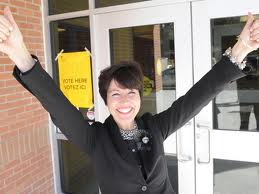 Jane McKenna the night she was elected the first time “This means that Halton Region, working with the City of Burlington, can submit an amendment to the province now to remove Burlington’s downtown mobility hub and MTSA designation from the Region’s Official Plan.”
“The Ford government has taken the position that municipalities may choose to take a phased approach to their municipal comprehensive review through multiple municipal official plan amendments under section 26,” said Minister Steve Clark. “As a result, removing the MTSA designation from Downtown Burlington could occur through a municipal official plan amendment under section 17 of the Planning Act.”

 By Pepper Parr By Pepper Parr
April 27th, 2020
BURLINGTON, ON
Ward 5 Councillor Paul Sharman weighs in on what happened to that development on Brant Street.
On August 31, 2017, the Planning and Building Department acknowledged that a complete application had been received for an Official Plan and Zoning By-law Amendment for 2100 Brant Street to facilitate the development of 233 townhouse units.
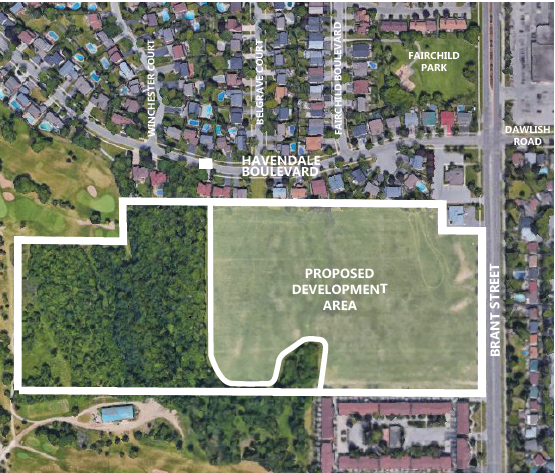 The ward Councillors; first Rick Craven and now Kelvin Galbraith were not opposed to the development. The original applications proposed the development of 233 townhouse dwelling units comprised of street townhouses located along Brant Street and a proposed public street and standard condominium townhouse units. The original net density of the development was 43.55 units per hectare and gross density was 21.07 units per hectare. The applications were requesting site specific exceptions to allow for the development.
Further to technical comments received from staff, other agencies and public feedback received through the processing of the applications, the applicant made changes to the proposed development and submitted revised studies, reports and a reconfigured draft plan of subdivision.
The applicants appealed the subject applications to the Local Planning Appeals Tribunal after the required time period established by the Planning Act expired. Notwithstanding the appeals, the City continued to work with the applicant in an effort to resolve what the City and its residents were concerned about. The result of these negotiations with the applicants, was Minutes of Settlement. This agreement was reached in November 2018 and supported a 212-unit townhouse development. This settlement agreement was based on the assessment from staff that the application satisfied all regulatory and planning requirements and was therefore defensible at LPAT.
 Paul Sharman listening to a delegation Despite the advice of staff, on December 17, 2018, the newly elected City Council, in a vote that was not unanimous, repudiated (i.e. cancelled) the settlement agreement. That decision not only pushed the City and the applicants towards an LPAT hearing but is also expected to lead to an awarding of costs to National Homes in an amount of approximately of $28,000 when the final settlements and awards are confirmed.
Notwithstanding the grim reality facing Council, City staff continued to work with the applicant in an effort to further refine the proposal to address concerns raised by members of Council and the neighbourhood surrounding the property.
At its meeting of April, 20, 2020 Burlington City Council approved the planning staff recommendation of Confidential Legal Report L-10-20 to accept a new offer of settlement between National Homes (Brant) Inc. (“National Homes”) and the City.
This settlement agreement presented to us was essentially based on the assessment from staff indicating that proposed amendments to the development proposal satisfied all regulatory and planning requirements and was therefore defensible at LPAT. The settlement proposed is almost identical to the rationale provided to the previous Council.
 Paul Sharman fighting for his political life in the fall of 2018 Sharman says he is “the only returning member of Council in 2018 who voted to support of the original settlement agreement with National Homes. That decision was based on two considerations.
The first being that the applicant had worked with community members and staff to achieve several modifications. Original 2018 approved settlement included:
• reduction of 21 units
• addition of 0.76 parkland
• addition of 7 townhomes suitable for families and seniors
The second consideration being the assessment of staff that the application satisfied all regulatory and planning requirements and was therefore defensible at LPAT.
“On April 20th, 2020, I again voted in support of what was essentially the same application that I supported in 2018, for the same reasons although, as I have noted, there were some further, minor, modifications.
“Ironically, it is possible that increased setbacks included in the 2020 settlement will actually increase the net density of the development. In other words, the development will be more compact.
“It is unfortunate that taxpayers will likely foot a $28,000 legal fee that will be awarded against the City resulting from the new 2018 Council decision to scrap the first settlement agreement.”
Is that a shot over somebody’s bow?
Related articles:
John Calvert’s J’Accuse
The Mayor’s rationale

 By Pepper Parr By Pepper Parr
April 27th, 2020
BURLINGTON, ON
It does sound a little ass-backwards – but they are on the right path.
The hospitality and entertainment sectors are hurting – they are bleeding.
With the weather beginning to look nice the idea of being on a patio in the afternoon when the work is done sounds very inviting.
Team Burlington gets it – not yet – but soon IF you stay home so that they can eventually get back into business.
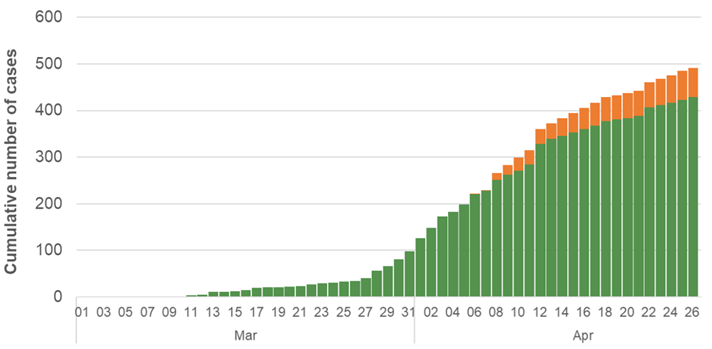 The curve is far from flat. The virus that is infecting people is being passed from person to person – not from someone from China. They are calling this initiative their STAY HOME to Get Back to Business campaign – they are encouraging people to support local business by staying home and practicing physical distancing which will ultimately help businesses open their doors sooner.
It isn’t just the hardest hit industries that are feeling the impacts of the global pandemic. Businesses of all sizes and across all industries are experiencing unprecedented challenges, including significant and unforeseen revenue loss, the need to lay off staff, supply chain disruptions, and uncertainty about the future of their business and when they will be able to reopen. Simultaneously, businesses are also facing tremendous pressure to digitize and shift existing business models to include online and contactless pick-up and delivery options.
Team Burlington recognizes these challenges and plans to leverage their audience and networks to help get Burlington businesses open as soon as possible. The STAY HOME(to Get Back to Business) campaign reinforces the message that is consistent with public health officials — the sooner people STAY HOME, the sooner the business community can open their doors and get back to business.
 Brian Dean, Executive Director of Burlington Downtown Business Association “Businesses of all sizes are being impacted by COVID-19″ said Brian Dean, Executive Director of Burlington Downtown Business Association, one of Burlington’s two Business Improvement Areas (the other being Aldershot Village BIA). “We hope this campaign will help Burlington residents understand that their actions and choices during this time have direct consequences on our business community.
We are getting asked a lot about how people can support their local businesses. One of the things you can do is stay home and practice physical distancing as much as possible.”
Craig Kowalchuk, Owner of Emma’s Back Porch and the Water Street Cooker and President of the Burlington Restaurant Association echoed Brian’s sentiment. “Temporarily laying off staff and closing down the restaurant has been one of the most difficult things I’ve had to do in my twenty-eight years of operations.” He went on, “You can help us get back to business by staying home, reduce your trips to the store and minimize contact with others. We can’t wait to welcome you back, for our twenty-ninth summer, but we can’t do that until everyone stays home.”
The STAY HOME campaign will be launched across social media, as well as through window decals displayed in the windows of downtown businesses. A video campaign featuring local business owners from across Burlington will also help spread the message.
Give Team Burlington credit for doing the right thing, the responsible thing. And remember all this when they are able to open their doors again.

 By Pepper Parr By Pepper Parr
April 27th, 2020
BURLINGTON, ON

We asked the two women who are providing Gazette readers with an ongoing commentary on how things are going in their households with the schools being closed. The province’s decision to keep the schools closed until the end of May might create situations that will be difficult for many parents.
Ashley Worobec, the Chiropractor who runs long distances when she can find the time, said she “didn’t have much to say – It really doesn’t change anything for us- we were expecting the date to be delayed, which it has been, and we’re prepping ourselves mentally for the possibility that the next extension will end the school year entirely.
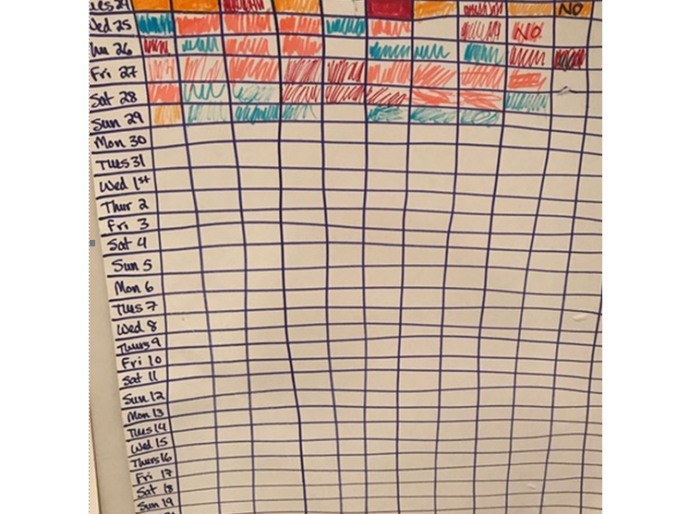 The Worobec family created a mammoth Task list to give the new approach to education some structure. “I do like how they’ve decided to watch and wait instead of just cancelling the school year entirely like some other provinces have, as that’s given us hope instead of looking ahead to months and months without school. At least this way, there’s still a glimmer of hope.”
Ashley’s two children seem to be coping quite well – the task list picture tells part of the story for their household.
Nicki St George said she “finds it frustrating to be stuck at home while the school closure date keeps getting pushed back further and further. It only serves to foster more uncertainty for myself and the kids. We are fortunate to have the time and technology available to facilitate learning from home but many people do not.
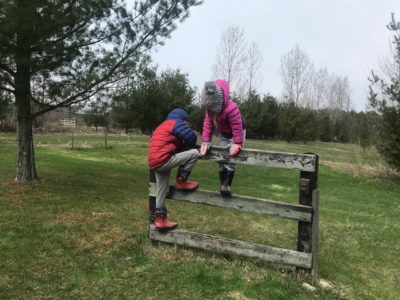 Getting them outdoors where they can burn off some of that energy. “Considering the preliminary data which suggests that school closures will have little impact on the spread of the virus, I think that the harms of keeping schools closed (specifically elementary schools) will likely outweigh the benefits.”
Mixed views.
One of the major issues during the months of short term school strikes was the number of On-line courses students were going to be required to take – with the strikes now settled teachers find themselves delivering every hour of instruction on-line.
Something ironic about how that turned out – teachers will get to learn that some courses can be done very well on-line and some parents might come to the realization that on-line instruction can be very effective in some situations.
The school boards take direction from the province. However, the school boards are the people that are going to have to deal with the disruption in the delivery of an education. They also have to look at the impact of the disruption on the quality of the education they deliver.
Moving from the end of elementary school and on into high school is a major right of passage for students. But what if high school starts with an hour in front of a computer monitor?
That’s an issue that senior school board staff find themselves thinking about.

 By Staff By Staff
April 27th, 2020
BURLINGTON, ON
While we are not yet out of the woods – not by any stretch of the imagination, all four Mayors in Halton Region, Burlington, Halton Hills, Milton and Oakville have formed the Halton Mayors Recovery Coordination Group
The four Mayors, Burlington Mayor Marianne Meed Ward, Halton Hills Mayor Rick Bonnette, Milton Mayor Gord Krantz and Oakville Mayor Rob Burton will coordinate and work together to prepare for a successful transition to a post COVID-19 emergency, reopening and recovery, and living with the changes it has brought.
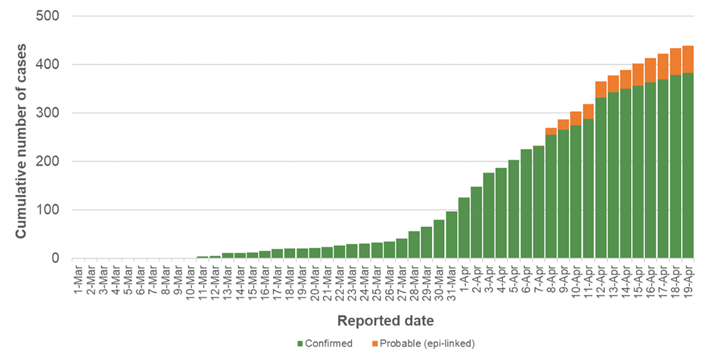 This curve has not flattened – the focus should be on getting the curve to change direction – creating a Group to Plan for a Recovery looks like a chance for a photo-op. While this does not mean that emergency measures put in place by the province, the region or individual cities and towns to slow the spread of COVID-19 are expected to be lifted in the near-term, it is prudent to begin to look ahead so that our plans can be ready to execute when the time comes.
The final phases of the pandemic response include the potential reopening of municipal facilities and the implementation of recovery efforts over the balance of the year. The dates of when recovery might begin are contingent on the continued slowing of the spread of the virus and the province lifting its emergency orders and restrictions, including those related to businesses and physical distancing.
“From the beginning of the COVID-19 crisis, we have stayed in contact as we collectively responded to the situation at hand, so it makes sense that we remain aligned as we plan for the post-COVID-19 recovery phase in our communities,” said Mayor Marianne Meed Ward.
 “All four Mayors have made the commitment to keep each other apprised of decisions being considered in each respective municipality, share best practices, and coordinate when it comes to the recovery planning. They will also ensure a continued close linkage with Halton Region, with the chair Gary Carr as an invited guest to our group when his schedule permits.” “All four Mayors have made the commitment to keep each other apprised of decisions being considered in each respective municipality, share best practices, and coordinate when it comes to the recovery planning. They will also ensure a continued close linkage with Halton Region, with the chair Gary Carr as an invited guest to our group when his schedule permits.”
__

 By Pepper Parr By Pepper Parr
April 27th, 2020
BURLINGTON, ON
 Education Minister Stephen Lecce Education Minister Stephen Lecce announced on the weekend that all publicly-funded schools will remain closed until at least May 31, 2020, as part of an effort to keep students, staff and families safe from COVID-19.
The extension was based on expert advice from the Chief Medical Officer of Health and health officials on the COVID-19 Command Table and is part of the government’s ongoing effort to stop the spread of the virus. The advice was to extend school closures for an additional period of time to permit updated modelling and data to inform next steps, given the government’s absolute commitment to safety.
“We will do whatever it takes to keep our students safe,” said Minister Lecce. “The government is taking a careful approach which provides our medical experts the time to review the modelling and make the best decision for the safety of our students and the future of learning.”
The government took immediate action to close schools in Ontario, the first in Canada to do so. The ministry continues to monitor the evolving situation and if necessary, the closure may be extended further to protect the health and safety of Ontario’s school communities.
At the same time the Ontario government is taking steps to ensure learning can continue. In March the province unveiled its Learn at Home portal. It offers all students high-quality resources, featuring made-in-Ontario math and literacy resources, created by Ontario-certified educators, in both English and French. Elementary resources are designed to help young students learn at home with interactive activities that encourage participation through entertaining and stimulating digital content. High school content was designed with a focus on STEM courses and ensures core competencies and skills are reinforced.
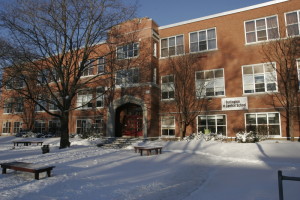 There won’t be a graduation ceremony and no prom either – but depend on the students to come up with something to celebrate leaving high school. “Regardless of what transpires over the coming weeks, Ontario’s students will be able to complete their school year with confidence,” added Minister Lecce. “In particular, for students in their final year, we are removing all impediments to ensure students graduate and pursue post-secondary education.”
In the event that they do reopen, school employees will have access as of May 29, 2020.
The Ministry of Education will move forward to replace the remainder of Professional Activity (PA) days and examination days with instructional time, as well as the introduction of an expanded summer learning program that will focus on credit recovery, supports for vulnerable students, and course upgrading. Boards are to find solutions at the local level in keeping with this direction while upholding collective agreement obligations.
The Minister of Education later said that the next time he makes a public announcement it will be to set out how the balance of the school year will be dealt with.
Later today Premier Doug Ford will unveil the framework for re-opening the province.

The Gazette has put together a team of parents who are at home taking care of their children while the province goes through school closures and the shut down of everything other than essential services.
Ashley Worobec and Nicki St. George will write regularly on how they are coping. We invite parents to take part in this initiative by adding comments to each Coping with COVID19 & the kids article.
 By Ashley Worobec By Ashley Worobec
April 27th, 2020
BURLINGTON, ON
Our mornings have still been a bit more structured and afternoons tend to be more whatever-we-feel-like.
One thing that I’ve found helpful for my Type-A personality, is writing out a list of the next day’s activities/tasks on the whiteboard on our fridge. Mornings almost always begin with a 5k run for myself and my dog, with my husband on the bike beside me, and more often than not, at least one of the kids comes on their bike too.
I haven’t been setting an alarm clock though, and in my “normal” life I’m often up at 4:45 or 5am, and out the door for my runs- these days I’m sleeping until I naturally wake up, which has been closer to 7:30 or 8am!
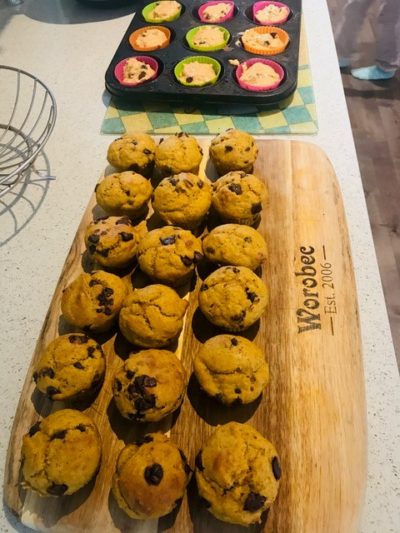 Baking is a constant and consistent activity in the Worobec household. I have been thinking about getting up for a sunrise run here and there, as the sunrise is my favourite time of the day, and it would also give me some solitude. I’m an introvert by nature, so I re-charge with alone time, and that’s been much harder to come by lately. Perhaps a sunrise run will happen next week….
After my run, we move onto schoolwork. I’m the one who tends to supervise the kids during their schoolwork, as my husband uses this time to do his own online work with his students (he’s a high school teacher). Depending on the day, this has usually been taking my kids 1-2 hours to complete. My son is in Grade 5 and my daughter is in Grade 2, and they seem to be adapting to e-learning quite well.
Both of their teachers have been exceptional, and have been great at providing a variety of assignments and tasks for them, and I know my kids miss seeing them in person. Both kids have been using FaceTime regularly to “see” their friends, and that’s been a big help to them.
We’re into week 7 now of the clinic closure, and Saskatchewan has announced that chiropractors can return to work (with appropriate PPE in place) on May 4th, so my colleagues and I have been closely watching that situation. It is quite a helpless feeling to have the clinic closed, but my work team is having online meetings twice per week to stay in touch and keep our morale high.
I’m also keeping in touch with some of my patients via virtual or telephone consultations, and that’s been really helpful for me personally, as it’s given me a sense of purpose surrounding my work and a small feeling of being able to help my patients who are in pain. I am anxious to return to work, and hopeful with the trending numbers that Ontario is showing.
One initiative that I have just begun is hosting “Movement You”, which is a 10-minute workout, LIVE online on my Facebook and Instagram pages (search “Dr. Ashley Worobec”)- it’s a way for me to connect with my community and to encourage my patients to stay active and moving, which is something I believe passionately in.
Last Friday was the first time doing this, and it was a wild success, with my kids participating in the workout too. I plan on making this a weekly thing, every Friday at 11:45am, with movements that people can do easily in their living rooms.
A couple of other fun things we did this week:
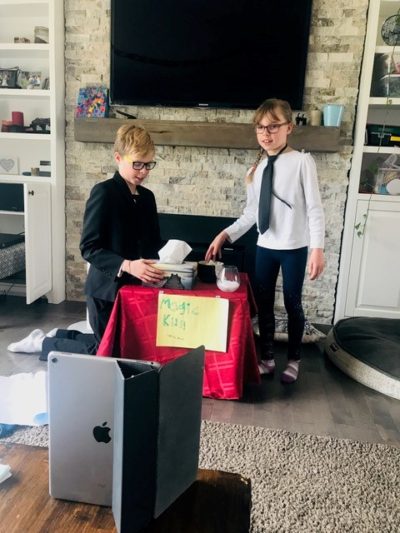 Virtual magic show for the relatives in Alberta 1. My kids put on a virtual magic show for our relatives in Alberta. I grew up in Alberta and my extended family is all still out West, so my kids are very used to using online platforms to talk to their grandparents and Aunts and Uncles. They looked up magic tricks on YouTube, practiced them, and then set up a little show. Their cousins and my parents loved it, and they were really proud of themselves.
2. We baked 5 dozen pumpkin chocolate chip muffins and then packaged them up and dropped them off on friend’s porches throughout the City, along with notes of support and encouragement.
3. We did a workout called “Heidi,” in honour of Constable Heidi Stevenson, who was tragically killed in the Nova Scotia shootings. I’m not sure who designed this workout, but this image has been circulating amongst the CrossFit community, and since my husband and I both go to a CrossFit gym, we jumped at this chance.
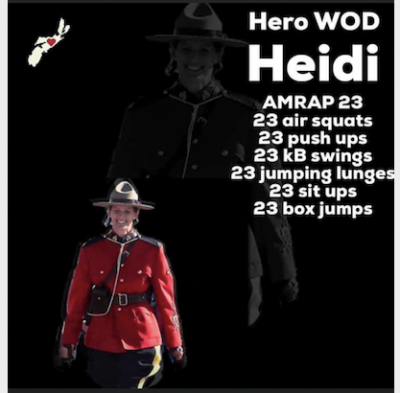 A workout called “Heidi,” in honour of Constable Heidi Stevenson It’s common for CrossFit to have “named workouts” based upon First Responder’s killed in the line of duty, and since our gym has loaned us some gym equipment to use at home, we did this workout in our driveway on Saturday afternoon- it’s 23 air squats, 23 pushups, 23 kettlebell swings, 23 jumping lunges, 23 situps, and 23 box jumps, as many rounds as possible for 23 minutes. The number 23 honours the fact that she served with the RCMP for 23 years.
4. We watched the “Stronger Together” Covid-19 broadcast benefit on CTV on Sunday evening, and especially loved the montage of “Lean On Me” at the end.
~

 By Staff By Staff
April 25th, 2020
BURLINGTON, ON
Getting into spring and thinking about summer is going to be harder this year than it was last.
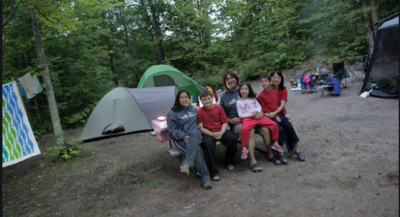 No camping in provincial parks – Maybe in June? The province announced on Friday that the government is extending the closure of Ontario’s provincial parks and conservation reserves to May 31, 2020.
This includes car camping, backcountry camping, roofed accommodations, day use opportunities, access points and all public buildings.
Provincial parks and conservation reserves will continue to remain fully closed to all recreational activities.
Reservations for arrivals up to, and including, any further closure extension date will be automatically cancelled and reservation holders will receive a full refund with no penalty. We are also providing penalty-free refunds to reservation holders who wish to change or cancel their 2020 camping reservation, regardless of arrival date.
This is part of the drive to keep us apart and not have groups of more than five people congregating in one place.
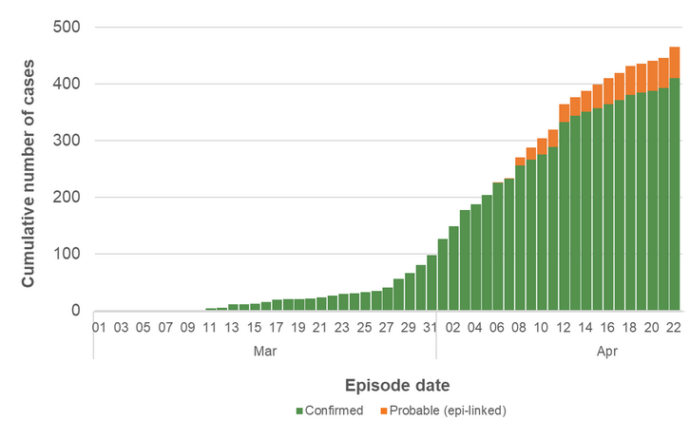 This is the infection curve for Halton – it hasn’t begun to flatten yet. That curve of COVID-19 infections is not flat enough – this kind of direction is going to be necessary until the number of infections stop increasing.
The virus that is now loose in the community is being passed from person to person – we know that. What we don’t know is who has it and who are they passing it to.

 By Pepper Parr By Pepper Parr
April 25th, 2020
BURLINGTON, ON
The Halton Region Public Health unit produces data on the status of the COVID-19 infection and the rate at which infections have grown and the number of people believed to have died as a result of the virus.
Cases over time
466 COVID-19 cases among Halton residents to date (410 confirmed + 56 probable)
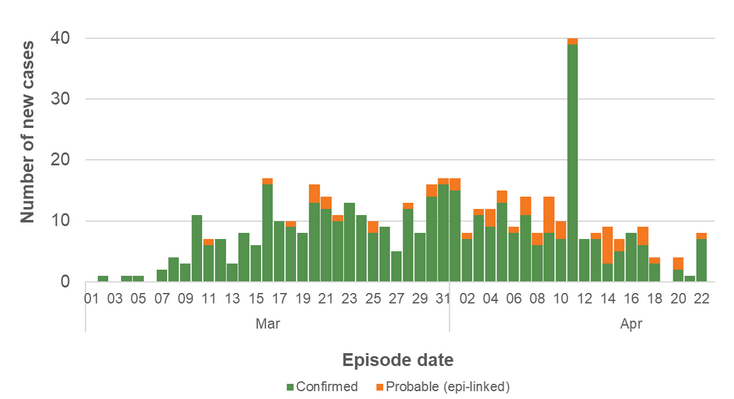 Figure 1: COVID-19 cases, by episode date, Halton Region, Mar. 1-Apr. 22, 2020 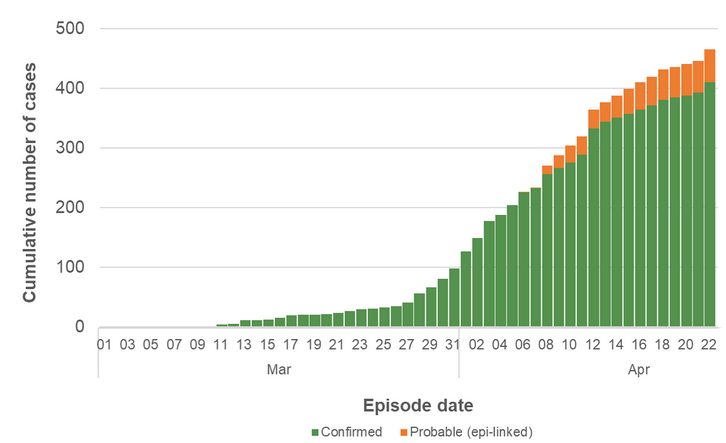 Cumulative COVID-19 cases, by episode date, Halton Region, Mar. 1-Apr. 22, 2020 Figures 1 and 2 show the 466 COVID-19 cases among Halton residents reported by end of the day on April 22. Unlike past reports, all cases have now been graphed according to their episode date, which is used to estimate the date that symptoms began. Figure 1 shows the number of new cases per day, while Figure 2 shows how cases have accumulated over time. Counts for the past 14 days should be interpreted with caution, since there is a delay between when a person becomes infected and when they develop symptoms, get tested, and are reported as a case. Please note the large increase on April 11 is due to expanded testing and identification of COVID-19 among asymptomatic individuals at Mountainview Residence.
Individuals who are lab-confirmed cases are shown in green. Individuals who are probable cases are shown in orange. Probable cases are epi-linked cases, which means they are presumed to have COVID-19 because they are symptomatic close contacts of cases or returning travelers who have COVID-19 symptoms.
Case demographics
70 cases were residents or patients of an institution experiencing an outbreak (15% of all cases)
64 cases work in health care (14% of all cases)
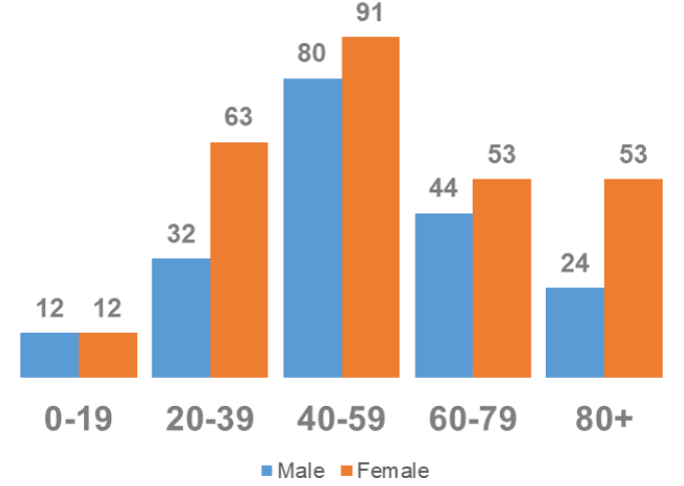 Figure 3: COVID-19 cases, by age and sex, Halton Region, 2020 Figure 3 shows that by end of the day on April 22, the most COVID-19 cases were among Halton residents aged 40-59 (with 171 cases, or 37%). 272 cases (59%) were female. Please note this figure excludes two cases with sex information pending.
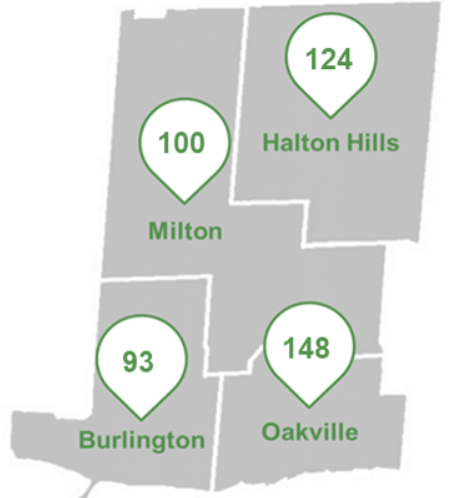 Figure 4: COVID-19 cases, by municipality of residence, Halton Region, 2020 Figure 4 shows that by end of the day on April 22, the greatest number of COVID-19 cases were among residents of Oakville (with 148 cases, or 32%). Please note this figure shows counts, and therefore does not take into account the different population sizes or age structures of the four municipalities. Counts in municipalities can also be inflated by outbreaks that have occurred within institutions in their boundaries. The figure excludes one case with municipality information pending.
Case exposure source
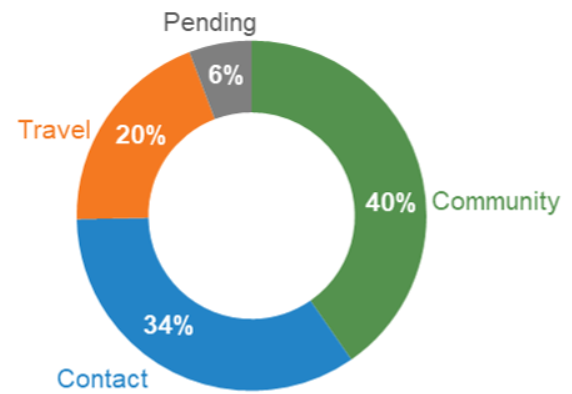 Figure 5: Percentage of COVID-19 cases, by exposure source, Halton Region, 2020 Figure 5 shows that by end of the day on April 22, 188 of Halton Region’s COVID-19 cases (40%) had no known travel or contact history, and therefore were believed to have acquired the virus within Ontario, making them community cases. 160 cases (34%) had contact with a confirmed case that was believed to be the source of their infection. 91 cases (20%) had a history of travel that was believed to have been the source of their infection. Information on exposure source was pending for the remaining 27 cases (6%).
Case outcomes
60 cases who have ever been hospitalized to date (29 listed as currently in hospital)
217 cases who have recovered to date
18 cases who have died to date (9 of the deceased were residents or patients of an institution experiencing an outbreak)
Institutional outbreaks
9 confirmed institutional outbreaks of COVID-19 are currently ongoing in Halton
12 confirmed institutional outbreaks of COVID-19 reported to Halton Region Public Health to date
Among the 12 confirmed institutional outbreaks reported to date, six (50%) have been in retirement homes, four (33%) have been in long-term care homes, and one each have been in a hospital and a group home. Nine of the outbreaks remain ongoing. Please note these counts do not include any suspected outbreaks that remain under investigation.
Lab testing
>6,000 Halton residents are known to have been tested for COVID-19 to date
Comparison to Ontario
12,879 total confirmed COVID-19 cases reported in Ontario to date
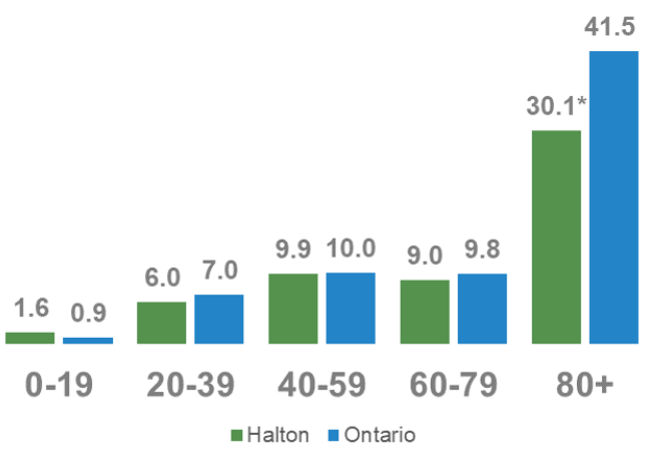 Figure 6: Age-specific rates of COVID-19 (per 10,000 population), Halton Region and Ontario, 2020 Figure 6 shows age-specific rates of COVID-19 for Halton and Ontario. Rates take into account the population size of each age group to make it possible to compare between different areas. Halton’s age-specific rates are currently similar to the provincial rates for all age groups except for residents aged 80+.
Halton has 30.1 cases per 10,000 residents aged 80+, which is statistically significantly lower than the 41.5 cases per 10,000 residents aged 80+ in Ontario overall. It is important to note that these rates will fluctuate as numbers increase throughout the pandemic, and that differences between age groups may reflect differences in the likelihood of developing symptoms and being tested.
Data limitations and data sources:
Halton case data: integrated Public Health Information System (iPHIS), extracted at 7:00 AM on April 23, 2020, to reflect data entered by the end of the day on April 22, 2020
Halton lab data: COVID Data Information System, extracted on April 20, 2020.
Ontario case data: Public Health Ontario, Epidemiologic Summary, COVID-19 in Ontario: January 15, 2020 to April 22, 2020, posted on April 23, 2020 to https://www.ontario.ca/page/2019-novel-coronavirus
Denominators for Halton and Ontario age-specific rates: Population projections [2020], IntelliHEALTH Ontario, extracted on April 8, 2020.
Data notes
All cases of diseases of public health significance diagnosed in Ontario are entered into iPHIS by local public health units. iPHIS is the Integrated Public Health Information System. It is a dynamic disease reporting system which allows ongoing updates to data previously entered. As a result, data extracted from iPHIS represent a snapshot at the time of extraction and may differ from previous or subsequent reports as data are updated.
The data only represent cases reported to public health and recorded in iPHIS. As a result, all counts will be subject to varying degrees of underreporting due to a variety of factors, such as disease awareness and medical care seeking behaviours, which may depend on severity of illness, clinical practice, changes in laboratory testing, and reporting behaviours.
Cases are included if their “diagnosing health unit” in iPHIS is Halton Region, which means counts include only individuals whose primary residence is in Halton Region. The case may not necessarily have been managed by Halton Region, if they were temporarily residing elsewhere during their case management period. Cases managed by Halton Region who normally live elsewhere but who were managed by Halton Region staff because they were temporarily residing in Halton during their case management period have not been included.
Cases for which the Disposition Status in iPHIS was reported as ENTERED IN ERROR, DOES NOT MEET DEFINITION, DUPLICATE-DO NOT USE, or any variation on these values have been excluded.
Figure 1 distinguishes between lab-confirmed and probable cases. Since April 7, probable cases are defined as epi-linked cases, meaning they are symptomatic close contacts of cases or returning travelers who have COVID-19 symptoms and therefore are presumed to have COVID-19. All other figures and numbers include both confirmed and probable cases combined.
Figures 1 and 2 use episode date, which is a field that is intended to approximate the symptom onset date for each case. It is calculated hierarchically, using symptom onset date if available; when it is not available, specimen collection date is used; if neither symptom onset nor specimen collection date are available, the lab test date is used; and finally, if none of these other dates are available, the date the case was reported to Public Health is used.
In subsequent reports, counts in Figures 1 and 2 may increase as cases are added from past dates as individuals become symptomatic, get tested, and their results are reported to Halton Region Public Health, as well as any past results are added due to delayed data entry or new arrival of lab results.
Cases are considered to be patients or residents of an institution experiencing an outbreak if they are linked to a confirmed Halton institutional outbreak in iPHIS, and they are not known to be a staff person at the institution.
Cases are considered to work in health care if they are known to have an occupation that involves caring for patients, e.g. physician, nurse, occupational therapist, recreational therapist, chiropractor, paramedic, midwife, orderly, etc. Individuals who work in health care settings but do not provide direct care to patients (e.g. managers, cleaning staff) have not been included.
Exposure type is determined by examining the exposure and risk factor fields from iPHIS to determine whether a case travelled, was a contact of a case or neither. A hierarchy has been applied as follows: Travel-related > Close contact of a confirmed case > Neither (indicating community acquisition) > Information pending.
Case outcomes (hospitalizations, recovery, deaths) reflect the latest available information reported to Halton Region Public Health and recorded in iPHIS by the extraction time.
Institutional outbreaks include outbreaks of COVID-19 in settings such as long-term care homes, retirement homes, hospitals, and prisons.
Lab testing data reflects only lab tests that have been reported to Halton Region Public Health and entered into CDIS. There may be more residents who have been tested but not reported to Public Health.
For daily Halton case tables and up-to-date information about how to protect yourself and others, please visit halton.ca/covid19
For daily provincial epidemiologic summaries and more information on COVID-19 in Ontario, please visit Ontario.ca/coronavirus
For national information on COVID-19 in Canada, please visit Canada.ca/coronavirus

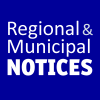 By Staff By Staff
April 24th, 2020
BURLINGTON, ON
Lakeshore Road from Nelson Avenue to Brant Street will be resurfaced (new top layer of asphalt).
Work will be completed during daytime hours.
From April 27 to May 29, lane reductions will be in place for the duration of this work. Priority will be provided to emergency services as required.
As part of this process, Brant Street from Pine Street to Lakeshore Road will be closed Tuesday, April 27, 2020, from 7 a.m. to 6 p.m.

 By Staff By Staff
April 23rd, 2020
BURLINGTON, ON
Austin Horton, a Grade 9 student from Georgetown District High School, is using his personal 3D printer to make dozens of personal protective equipment (PPE) to help medical professionals stay safe during the COVID-19 pandemic.
When Austin read about the need for PPE on social media in early April, he didn’t hesitate to fire up his 3D printer at home to start making plastic face shields.
 Grade 9 student Austin Horton saw a need for Face Shields – went into production and has delivered 80 so far. “I found the design online and slightly adjusted it for my printer,” he said. “It feels good to be doing this. I’ll keep doing this for as long as we have materials and it’s necessary.”
He has printed 80 shields so far. Each one takes about an hour and he prints around a half dozen a day. Austin leaves the PPE in a sealed bag at the front of his home and it is picked up by St. John Ambulance twice a week. He says the shields are being distributed to non-hospital medical professionals.
Michael Gallant, Principal at Georgetown District High School, said Austin’s PPE effort brings important hope to the local community.
“Like the residents of Georgetown, GDHS students and staff look for ways to support and improve their community and are committed to the success of all,” he said. “It is this dedication to the welfare of others that makes Georgetown such a special place. Find a way to do something that helps others and you will spread the hope and positivity that will get us through this challenge.”
Austin’s parents Krista and Shaun are very proud of their son’s effort to help people during these challenging times.
“Austin has always been very generous with his 3D printer,” Shaun said, noting he has made items to sell to fundraise for charities. “When it comes to helping others, he is always willing to assist wherever he can.”
“As soon as he was advised of the call for help, Austin offered to help immediately,” Krista said. “We thank (frontline workers) for taking time away from their family and friends to care for those who are not well and unable to have their families with them.”
Tim Bauer, Executive Director of St. John Ambulance, Halton-Hamilton Region, is grateful for Austin’s effort to help.
“The incredible work (Austin) is doing will go a long way toward ensuring public safety in this time of crisis,” Bauer said. “St. John Ambulance sincerely thanks him for understanding the need for PPE and for choosing to make an impact in the Halton community during a time of such great need in the battle against COVID-19.”

 By Staff By Staff
April 23rd, 2020
BURLINGTON, ON
The Halton Regional Police Service’s Child Abuse and Sexual Assault Unit (CASA) and Halton Children’s Aid Society (Halton CAS) are urging residents to remain vigilant in reporting suspected child abuse.
The majority of suspected child abuse reports normally come from third-party sources, increased levels of isolation in the past weeks have resulted in a marked decrease in the number of reports of suspected child abuse/neglect.
 Children trust – learning not to trust takes their childhood away from them. “We normally receive concerns from schools, friends, other parents, coaches and daycare providers,” says Halton Regional Police Service Detective Sergeant Crystal Kelly. “With social distancing measures in place and increased stress on families, there is little opportunity for children to interact with or reach out to those they trust.”
The Halton Regional Police Service (HRPS) has responded to eight (8) calls in April, 2020 regarding suspected child abuse, compared to 30 calls during the same time period in April, 2019, a 73 per cent decrease year over year.
Similarly, the Halton CAS has observed as 27 percent decrease in calls in April 2020 compared to 2019. Since the beginning of April, 2020, only 85 new cases have been opened by Halton CAS, compared to 169 during the same period in April, 2019, a 50 per cent decrease year over year.
“At Halton Children’s Aid Society, we are concerned about the increased risk of child abuse and neglect due to families being isolated from the community,” says Jennifer Binnington, Director of Protection Services at the Halton Children’s Aid Society.
“We understand this is a very stressful time for many families and we want you to know that we are an essential service and are open to assist and support children, youth and families 24 hours a day, 7 days a week. Please call us if you have any concerns or worries about a child during this time.”
 The HRPS and Halton CAS are asking that everyone remains mindful of the welfare of their neighbours, their children’s friends and classmates, and their relatives. It is crucial that residents also speak to their children about what to do if a friend confides in them that they are not safe at home. The HRPS and Halton CAS are asking that everyone remains mindful of the welfare of their neighbours, their children’s friends and classmates, and their relatives. It is crucial that residents also speak to their children about what to do if a friend confides in them that they are not safe at home.
Victims or friends/family of victims are encouraged to contact the Halton Regional Police Service, Halton Children’s Aid Society or other community resources if child abuse or neglect is happening.
Help is available.
The following is a list of valuable support services and resources in Halton Region for victims of child abuse:
• Halton Regional Police Service Child Abuse and Sexual Assault Unit 905-825-4777
• Halton Children’s Aid Society 905-333-4441 or 1-866-607-5437
• Kid’s Help Phone 1-800-668-6868 (24-hour crisis line)
• Radius Child & Youth Services 905-825-3242 (Oakville) or 1-855-744-9001
• Halton Women’s Place 905-878-8555 (north) or 905-332-7892 (24-hour crisis line)

 By Staff By Staff
April 23rd, 2020
BURLINGTON, ON
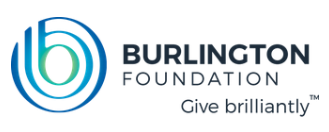 The Burlington Foundation today announced the first round of charities that will receive $163,500 from the Covid-19 Pandemic Response Fund since the Foundation announced the fund on March 31; 17 grants were announced. The Burlington Foundation today announced the first round of charities that will receive $163,500 from the Covid-19 Pandemic Response Fund since the Foundation announced the fund on March 31; 17 grants were announced.
Through the generosity of donors, the Pandemic Response Fund has grown to over $400,000 to support both community-based response efforts through two phases of granting, and a third phase that will assist charities in their recovery efforts recognizing that this pandemic will have long-term implications for the non-profit sector.
“The Covid-19 Pandemic Fund is designed to be a rapid response solution to the immediate and ongoing challenges facing our front-line charities as they struggle to meet the growing demand of community members impacted by Covid-19,” says Colleen Mulholland, President and CEO of Burlington Foundation.
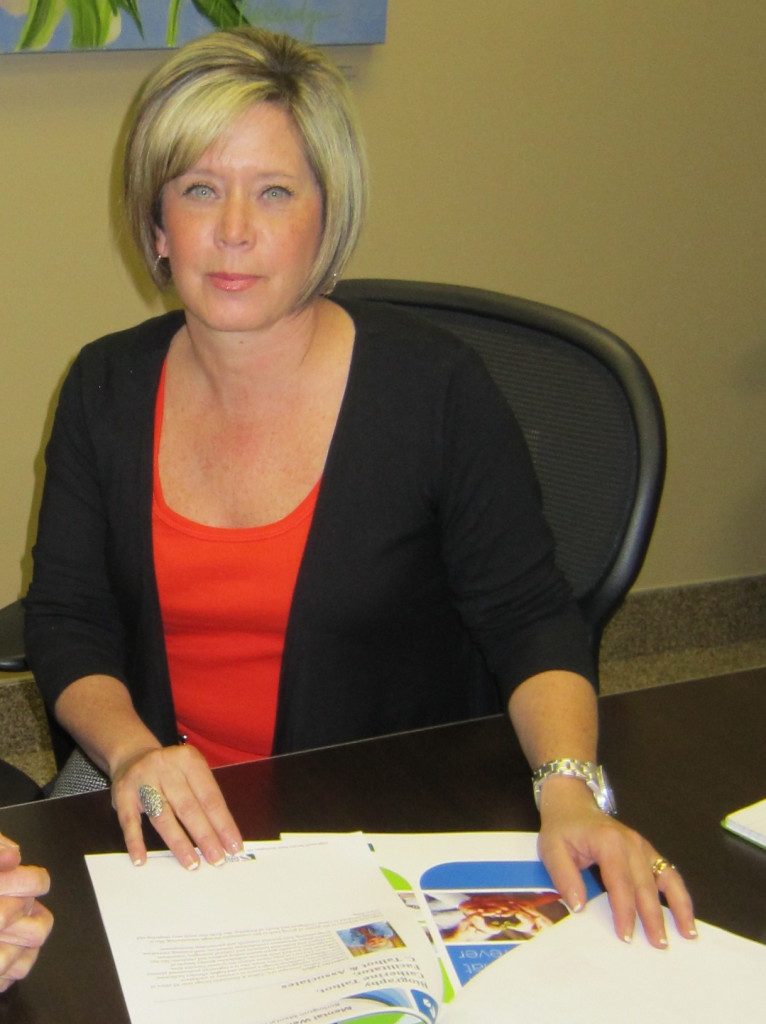 Colleen Mulholland, President and CEO of Burlington Foundation. The first phase of grantees provides a range of much-needed supports to high need, vulnerable people and families including those experiencing food insecurity; isolated seniors; community members with disability or mental health challenges; medical assistance; and safe housing. Second phase of granting will open on May 1.
“We are humbled by the care these front-line charities are providing to our friends and neighbours in great need during these unprecedented times. We are also honoured to partner with our fundholders and donors who are sending a loud caring message that we are all in this together,” Mulholland says.
Here are just a few of the grants being distributed to front-line charities:
 • $10,000 to Burlington Food Bank & Open Doors of St. Christopher’s to purchase fresh food and staples for over 135 households increasing at a rate of 20% per month • $10,000 to Burlington Food Bank & Open Doors of St. Christopher’s to purchase fresh food and staples for over 135 households increasing at a rate of 20% per month
• $10,000 to Compassion Society of Halton to acquire non-perishable food and hygiene supplies to help support over 1,200 clients a month and increasing
• $10,000 to ROCK (Reach Out Centre for Kids) to adapt virtual therapy programming to support
over 300 clients with need escalating
• $10,000 to YMCA to adapt seniors’ programming to virtual platforms addressing isolation issues for nearly 900 Burlington seniors
• $15,000 to Halton Women’s Place to provide safe housing and healthy meals for 3 families
• $15,000 to Joseph Brant Hospital Foundation to aid in the purchase of PPE, equipment and
related supplies as the hospital continues to battle Covid-19
The complete list of awarded grants is HERE.
Providing these critical emergency grants in this time of tremendous need would not be possible without the kindness of donors. Our heartfelt thank you to our many donors including: The Paletta Family, Pioneer Energy, Randy and Denise Reeve Family Fund, Milne Family Foundation Fund, Pieczonka Family Foundation Fund, LKH Spirit Fund, BDO Burlington Community Fund, Dalton Timmis Group Fund and several community donors.
To learn more about the Foundation’s Covid-19 Pandemic Response Fund, and how to support your community through a donation, please visit the Foundation web site.

 By Staff By Staff
April 23rd, 2020
BURLINGTON, ON
 Next COVID-19 Virtual Business Support Forum will be held at DeGroote – on the South Service Road. The Business Strategy & Planning session with DeGroote School of Business on April 28 has been rescheduled to May 5.
The event is part of the Team Burlington COVID-19 Virtual Business Support Forum Series.


 By Christopher Boyd By Christopher Boyd
April 23rd, 2020
BURLINGTON, ON
The Gazette uses Malware to secure its web sites. There are any number of software applications that can be used – we found Malware to work well for us.
One of the added values is a newsletter they publish. In the most recent version they published a piece of just what “free” software is all about. Well worth reading.
It’s almost impossible not to rely on social networks in some way, whether for personal reasons or business. Sites such as LinkedIn continue to blur the line, increasing the amount of social function over time with features and services resembling less formal sites, such as Facebook. Can anyone imagine not relying on, of all things, Twitter to catch up on breaking coronavirus news around the world instantly? The trade off is your data, and how they profit from it.
Like it or not—and it’s entirely possibly it’s a big slab of “not”—these services are here to stay, and we may be “forced” to keep using them. Some of the privacy concerns that lead people to say, “Just stop using them” are well founded. The reality, however, is not quite so straightforward.
 For example, in many remote regions, Facebook or Twitter might be the only free Internet access people have. And with pockets of restriction on free press, social media often represents the only outlet for “truth” for some users. There are some areas where people can receive unlimited Facebook access when they top up their mobiles. If they’re working, they’ll almost always use Facebook Messenger or another social media chat tool to stay in touch rather than drain their SMS allowance. For example, in many remote regions, Facebook or Twitter might be the only free Internet access people have. And with pockets of restriction on free press, social media often represents the only outlet for “truth” for some users. There are some areas where people can receive unlimited Facebook access when they top up their mobiles. If they’re working, they’ll almost always use Facebook Messenger or another social media chat tool to stay in touch rather than drain their SMS allowance.
Many of us can afford to walk away from these services; but just as many of us simply can’t consider it when there’s nothing else to take its place.
Mining for data (money) has never been so profitable.
But how did this come to be? In the early days of Facebook, it was hard to envision the platform being used to spread disinformation, assist in genocide, or sell user data to third-parties. We walk users through the social media business model and show how the inevitable happens: when a product is free, the commodity is you and your data.
Setting up social media shop
Often, Venture Capital backing is how a social network springs into life. This is where VC firms invest lots of money for promising-looking services/technology with the expectation they’ll make big money and gain a return on investment in the form of ownership stakes. When the company is bought out or goes public, it’s massive sacks of cash for everybody. (Well, that’s the dream. The reality is usually quite a bit more complicated).
It’s not exactly common for these high-risk gambles to pay off, and what often happens is the company never quite pops. They underperform, or key staff leave, and they expand a little too rapidly with the knock-on effect that the CEO suddenly has this massive service with millions of users and no sensible way to turn that user base into profit (and no way to retain order on a service rife with chaos).
At that point, they either muddle along, or they look to profit in other ways. That “other way” is almost always via user data. I mean, it’s all there, so why not? Here are just some of the methods social networks deploy to turn bums on seats into massive piles of cash.
Advertising on social media
This is the most obvious one, and a primary driver for online revenue for many a year. Social media platforms tend to benefit in a way other more traditional publishers cannot, and revenue streams appear to be quite healthy in terms of user-revenue generation.
Advertising is a straight-forward way for social media networks to not only make money from the data they’ve collected, but also create chains where external parties potentially dip into the same pool, too.
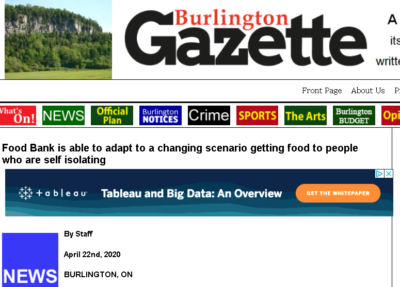 That advertisement, beneath the headline, offering a free report is an example of an advertiser using the Google AdSense platform to put their advertisement in front of the audience they want. The Gazette earns a couple of pennies for each that someone clicks on. At its most basic, platforms can offer ad space to advertisers. Unlike traditional publishing, social media ads can be tailored to personalized data the social network sees you searching for, talking about, or liking daily. If you thought hitting “like” (or its equivalent) on a portal was simply a helpful thumbs up in the general direction of someone providing content, think again. It’s quite likely feeding data into the big pot of “These are the ads we should show this person.”
Not only is everything you punch into the social network (and your browser) up for grabs, but everything your colleagues and associates do too, tying you up in a neat little bow of social media profiling. All of it can then be mined to make associations and estimations, which will also feed back to ad units and, ultimately, profit.
Guesstimates are based on the interests of you, your family, your friends, and your friends’ friends, plus other demographic-specific clues, such as your job title, pictures of your home, travel experiences, cars, and marriage status. Likely all of these data points help the social network neatly estimate your income, another way to figure out which specific adverts to send your way.
After all, if they send you the wrong ads, they lose. If you’re not clicking through and popping a promo page, the advertisers aren’t really winning. All that ad investment is essentially going to waste unless you’re compelled to make use of it in some way.
Even selling your data to advertisers or other marketing firms could be on the table. Depending on terms of service, it’s entirely possible the social platforms you use can anonymise their treasure trove and sell it for top dollar to third parties. Even in cases where the data isn’t sold, simply having it out there is always a bit risky.
There have been many unrelated, non-social media instances where it turned out supposedly anonymous data, wasn’t. There are always people who can come along afterwards and piece it all together, and they don’t have to be Sherlock Holmes to do it. All this before you consider social media sites/platforms with social components aren’t immune to the perils of theft, leakage, and data scraping.
As any cursory glance of a security news source will tell you, there’s an awful lot of rogue advertisers out there to offset the perfectly legitimate ones. Whether by purchase or stumbling upon data leaked online, scammers are happy to take social media data and tie it up in email/phone scams and additional fake promos. At that point, even data generated through theoretically legitimate means is being (mis)used in some way by unscrupulous individuals, which only harms the ad industry further.
Apps and ads
Moving from desktop to mobile is a smart move for social networks, and if they’re able to have you install an app, then so much the better (for them). Depending on the mobile platform, they may be able to glean additional information about sites, apps, services, and preferred functionalities, which wouldn’t necessarily be available if you simply used a mobile web browser.
If you browse for any length of time on a mobile device, you’ll almost certainly be familiar with endless pop-ups and push notifications telling you how much cooler and awesome the app version of site X or Y will be. You may also have experienced the nagging sensation that websites seem to degrade in functionality over time on mobile browsers.
Suddenly, the UI is a little worse. The text is tiny. Somehow, you can no longer find previously overt menu options. Certain types of content no longer display correctly or easily, even when it’s something as basic as a jpeg. Did the “Do you want to view this in the app?” popup reverse the positions of the “Yes” and “No” buttons from the last time you saw it? Are they trying to trick you into clicking the wrong thing? It’s hard to remember, isn’t it?
A cynic would say this is all par for the course, but this is something you’ve almost certainly experienced when trying to do anything in social land on a mobile minus an app.
Once you’re locked into said app, a brave new world appears in terms of intimately-detailed data collection and a huge selection of adverts to choose from. Some of them may lead to sponsored affiliate links, opening the data harvesting net still further, or lead to additional third-party downloads. Some of these may be on official platform stores, while others may sit on unofficial third-party websites with all the implied risk such a thing carries.
Even the setup of how apps work on the website proper can drive revenue. Facebook caught some heat back in 2008 for their $375USD developer fee. Simply having a mass of developers making apps for the platform—whether verified or not—generates data that a social network platform can make use of, then tie it back to their users.
It’s all your data, wheeling around in a tumble drier of analytics.
Payment for access/features
Gating access to websites behind paywalls is not particularly popular for the general public. Therefore, most sites with a social networking component will usually charge only for additional services, and those services might not even be directly related to the social networking bit.
LinkedIn is a great example of this: the social networking part is there for anybody to use because it makes all those hilariously bad road warrior lifestyle posts incredibly sticky, and humorous replies are often the way people first land on a profile proper. However, what you’re paying for is increased core functionality unrelated to the “Is this even real?” comedy posts elsewhere.
In social networking land, a non-payment gated approach was required for certain platforms. Orkut, for example, required a login to access any content. Some of the thinking there was that a gated community could keep the bad things out. In reality, when data theft worms started to spread, it just meant the attacks were contained within the walls and hit the gated communities with full force.
The knock-on effect of this was security researchers’ ability to analyse and tackle these threats was delayed because many of these services were either niche or specific to certain regions only. As a result, finding out about these attacks was often at the mercy of simply being informed by random people that “X was happening over in Y.”
These days, access is much more granular, and it’s up to users to display what they want, with additional content requiring you to be logged in to view.
Counting the cost
Of the three approaches listed above, payment/gating is one of the least popular techniques to encourage a revenue stream. Straight up traditional advertising isn’t as fancy as app/site/service integration, but it’s something pretty much anybody can use, which is handy for devs without the mobile know-how or funds available to help make it happen.
Even so, nothing quite compares to the flexibility provided by mobile apps, integrated advertising, and the potential for additional third-party installs. With the added boost to sticky installs via the pulling power of social media influencers, it’s possibly never been harder to resist clicking install for key demographics.
The most important question, then, turns out to be one of the most common: What are you getting in return for loading an app onto your phone?
It’s always been true for apps generally, and it’ll continue to be a key factor in social media mobile data mining for the foreseeable future. “You are the product” might be a bit long in the tooth at this point, but where social media is concerned, it’s absolutely accurate. How could the billions of people worldwide creating the entirety of the content posted be anything else?

 By Staff By Staff
April 22nd, 2020
BURLINGTON, ON
 Food Banks are now serving the needs of a much different demographic. Robin Bailey, Chief Cheese at the Food Bank, is shouting out a big thanks to the people who are helping get hampers of food to people who for a number of reasons aren’t able to get out of the house to shop for themselves.
The number of people who need support means needing more food, which we are fortunate enough to have – the amount coming in to meet this new demand needed a place to be stored –Access Storage donated space and is even managing the delivery for us as volunteers themselves. It was perfect timing too with the Feed Ontario support coming in this week.
We had a few clients let us know in advance that they have been diagnosed with or are potential cases for the COVID-19 virus. We let our volunteer drivers know that there is that potential for certain homes and allow them to opt-out of doing the delivery if they don’t feel comfortable.
What we do is drop off food at the door (and we don’t knock) then the driver goes back to their car and phones the client to let them know it is ready at their door and then they come out to get the food – that way there is absolutely no contact. Please let your friends and neighbours know that we are here for them and ask them to reach out to us. Deliveries are up but we are prepared.
If you are in need or know of someone who could use our help have them email us at info@burlingtonfoodbank.ca or call 905-637-2273 to make arrangements to have food dropped at the door. If you live in Burlington, we are here to help.
Robin is a member of the Mayor’s Task Force. “They met last night via Zoom” said Bailey, ” it took hours – so much to deal with right now. We really have a good group on the board that want to do everything they can for the community; nice to see such wonderful people working so hard together but apart.”
Visual update
Donations are the lifeblood of the Food Bank – keep them in mind.

 By Pepper Parr By Pepper Parr
April 22nd, 2020
BURLINGTON, ON
In a Statement published in the Mayor’s Newsletter – A Better Burlington – Mayor Meed Ward wrote:
City Council, at a Closed session accepted a proposed revised plan for a townhouse and semi-detached development at 2100 Brant Street. The proposal will be decided by the Local Planning Appeal Tribunal (LPAT) at a hearing scheduled in July.
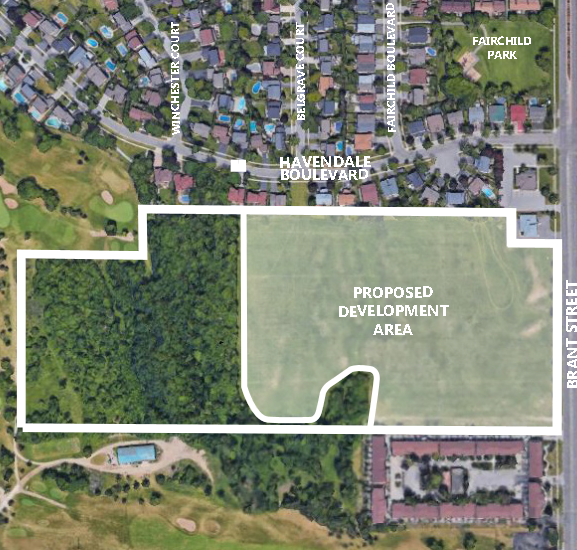 It is a piece of land that was farmed for centuries. It was pristine – and good have been a model community. The plans do not include anything near the traditional back yard. The original proposal was for 12 townhouse blocks with a total of 83 units and three condominium townhouse blocks with 150 units, for a total development of 233 units. There was no parkland. Also included in the applications are a woodlot block as well as a natural heritage system block. The proposed development site has a total area of 11.1 hectares (27.2 acres). The developable area is 5.04 hectares.
The land is currently vacant and has been historically used for agricultural purposes.
The former City Council had approved a revised proposal in November 2018, before the new council was sworn in but after the election when 5 of 7 members of the previous council were not returning due to defeat or retirement.
Current City Council rescinded that plan in December 2018 in an effort to give residents, staff and the applicant additional time to improve the plan and come to a consensus on a revised development.
A group of citizens, primarily representing residents in the neighbourhood north of the development, formed Vision 2100 Brant Neighbours Association, an incorporated group that received Party status at the LPAT hearing to present evidence on behalf of residents.
Representatives of the townhouse condominium board immediately to the south of the project had earlier issued a letter of support for the November revised proposal, considering their issues (primarily around setbacks and drainage) to be settled.
City Council and Vision 2100 received a revised proposal in March 2020. This proposal was provided directly to the Vision 2100 citizen’s group at a meeting March 10 with the applicant and Ward Councillor. The proposal was further discussed April 2 via teleconference with Vision 2100 representatives and the Ward Councillor and Mayor, to seek citizen input on the proposal.
To date, Vision 2100 has not provided any suggested changes or feedback on the proposal, but did raise additional questions around parking, snow storage, traffic, and storm water management. These were answered by the applicant by email to the residents (see background below), and addressed in the revised proposal to the city’s satisfaction.
The new proposal improves on the original application as well as the November 2018 proposal with the following changes:
Reducing the unit count from 212 to 210 (down from 233 in the original proposal)
In the Northwest area of the development on both sides of the Almonte Drive extension, replacing six 2-storey townhouse units with 4 semi-detached 1.5 storey bungalofts
Increasing setbacks from the homes to the north, from 9 metres to 10 metres; in some areas the setback is 11 metres
Increasing the senior-friendly units with ground floor bedrooms to aid accessibility, from 7 to 16 units
Provision of a 0.3 hectare (0.76 acre) centrally located Public Park.
City council voted to accept the revised proposal at the council meeting of April 20, 2020.
The details of that March plan, and the planning justification for supporting it provided by city staff, are included in the planning staff analysis here: 2100 Brant Planning Analysis
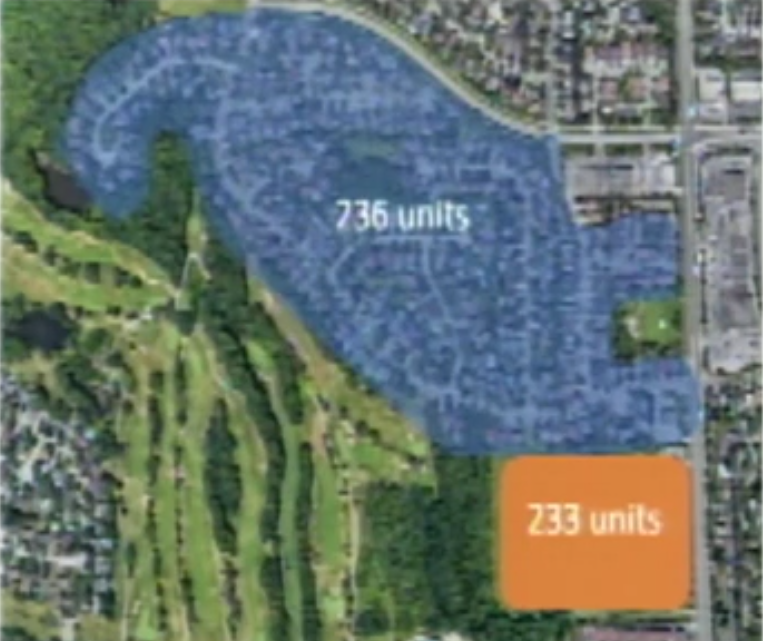 The orange is where the proposed 233 units were to go – that has been reduced to 210 Unlike the vast majority of municipalities, Burlington releases the planning analysis for matters which the municipality is supporting approval of by the LPAT, in advance of the hearing. This policy change was implemented by the new City Council to ensure maximum transparency with residents about the basis of our decision-making.
The final decision on the revised proposal will be made by the LPAT. The city and applicant will appear in support of the proposal.
Vision 2100 is a registered Party to the hearing which gives them the right at the hearing to call evidence (witnesses, studies or both) to refute or support the proposal, cross examine city or applicant witnesses, or suggest further modifications to the proposal. The City of Burlington, the applicant (National Homes) and the Region of Halton are the other registered Parties to the hearing. There are two registered Participants to the hearing who can provide feedback at the hearing as well.
Details on the original application submitted in 2017, revisions to the proposal, and details of the LPAT hearing are available on the project page for the development here created when the application was received: Current Development Applications, Ward 1, 2100 Brant St
Below is additional background, answers to some questions and a statement from the Mayor and Ward councillor.
Statement from Mayor Marianne Meed Ward and Ward 1 Councillor Kelvin Galbraith on 2100 Brant:
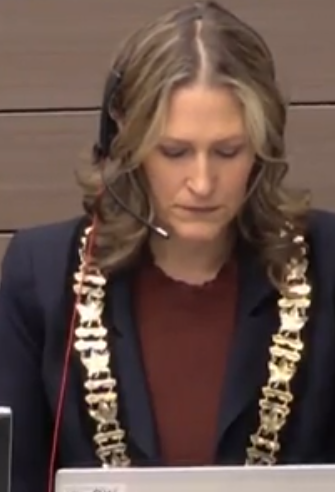 Mayor Marianne Meed Ward Resident input over several years, including the work of Vision 2100, has improved this application for the better, and we thank them for that.
Though the most recent proposal may not be exactly what residents or Councillors were hoping for, it does include more green space than the original proposal, including a new park, fewer units, less height and density, more variety and senior-friendly options, increased setbacks and better transition to the neighbourhoods to the north and south. The recent questions raised by residents around parking, traffic, snow storage and storm water management have been addressed.
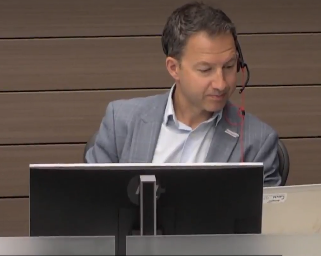 Ward 1 Councillor Kelvin Galbraith – working part time as a DJ? In accepting the revised proposal, council considered a number of factors, including public input, the improvements made that addressed some of the concerns raised, the planning justification provided by staff, and advice from legal counsel.
Our decision also factored in some practical realities, including the inability to secure a planning witness that was of the opinion that the November 2018 proposal did not overall represent good planning, the likelihood that a hearing would not produce a different result, and the possibility that city taxpayers could be required to pay the entire costs of the applicant at a lengthy hearing. In addition, city staff who supported the November proposal would likely have been required to testify on behalf of the applicant, at city taxpayers expense.
We also considered that notwithstanding council accepting a revised proposal, there remain options for continued public input, especially for Vision 2100, which can provide feedback or modifications on the revised proposal, and/or proceed as a party to the hearing and call evidence and witnesses.
We believe we achieved the best outcome possible for residents in this case, and your input directly made that happen.
Background and Answers to Questions:
How has public input been gathered on this application?
This application has been under review since 2017, with multiple points of public input along the way. A citizen’s group, Vision 2100, was formed to represent the concerns of residents primarily north of the development site. A citizen’s group was formed to the south to represent the interests of the townhouse development to the south. They submitted a letter of support for the November 2018 revised proposal.
The applicant met with the public over 12 times in that period, in either organized public meetings or smaller resident meetings.
There was a neighbourhood meeting Oct. 12, 2017, a statutory public meeting April 3, 2018 where residents presented detailed feedback and suggested modifications to council. Some council members at the time remarked that they were the best and most comprehensive presentations they had heard. There was a further open house to discuss revised plans July 17, 2018.
Throughout 2019 there have been numerous additional consultations with the applicant, city staff and Vision 2100, individually or as a group, to address the remaining concerns of the community. They included general over development of the site with related issues, and the interface of the development to the single family neighbourhood to the north, at Almonte Drive/Belgrave Court/Havendale Blvd.
In February 2020 the applicant advised it was prepared to make changes to the plan to address the resident concerns. In March they submitted a revised proposal to Vision 2100, and city staff. City Council received the proposal in early April.
How is public input reflected in the final proposal?
Since the original application, there have been at least 11 major revisions as a result of public, staff and council input, including a reduction in units, increased parkland, increased setbacks from the neighbourhoods to the north and south, reduced height of some units and conversion from townhouses to semi-detached, and provision of accessible, senior friendly semi-detached bungalofts. There have been three different proposals including the most recent one.
The proposal was provided directly to the Vision 2100 citizen’s group at a meeting March 10 with the applicant and Ward Councillor. The proposal was further discussed April 2 via teleconference with Vision 2100 representatives and the Ward Councillor and Mayor, to seek citizen input on the proposal.
To date, they have not provided feedback on the most recent proposal, but they did raise several outstanding questions via email related to traffic, parking, snow storage and storm water management. These questions were raised with the applicant by the Mayor and Ward Councillor on residents behalf, with the response as follows:
Traffic on Havendale, Fairchild and Brant St. Was a traffic study produced and taken into account? ANSWER: A traffic study was provided to Vision 2100 previously with the analysis describing the difference of a single family development and a townhouse development completed by a professional traffic engineer, outlining that a single family home development would generate more traffic. City staff reviewed and supported the findings of the study.
Parking, no street parking on private roads and limited visitors parking. Where do visitors park? ANSWER: Visitor parking is provided in the development on both public roads interior to the site and private roads as detailed in the attached site plan (also provided to Vision 2100).
The Zoning By-law requires 54 visitor parking spaces, whereas 59 are proposed. In addition 25 on-street parking spaces could be accommodated along the Almonte Drive extension.
Snow removal. There is no room to pile snow. Does the City have a plan to resolve that problem? ANSWER: The site plan attached to the revised proposal identifies areas where snow storage will be designated, in the bottom left and top right areas of the development.
Storm Water management. This has been a serious issue for the residents, based on actual flooding experiences where the empty lot at 2100 Brant served as a sink which helped to mitigate the flooding. Now there will be no sink because the area will be developed. The proposal is for an underground collection system with tanks which can be drained into the existing stormwater sewer at Brant Street. The question is, will there be enough capacity to accommodate two major rain storms in a row and will the system work properly? ANSWER: The design was prepared by a professional engineer based on their experience and history of developing many projects within the GTA with a similar design. Burlington City engineering staff had their professional engineers along with the Region of Halton’s professional engineers review the design of the system and both have been satisfied.
Why was this appealed to the Local Planning Appeal Tribunal?
Developers and residents have equal legal right in Ontario to appeal any decision of city council on a development matter to the LPAT, to seek a different decision.
Further, an applicant can appeal to the LPAT if the municipality exceeds the provincially mandated timelines to make a decision, which at the time of this application were 180 days.
The applicant, residents and staff agreed to continue to work together on the project beyond the 180 day time frame to try to come to a better outcome, thus setting aside the deadline. This application is now in its third year of review.
However, this changed when the previous provincial government announced it was making changes to the LPAT (then called the Ontario Municipal Board) to restrict what could be appealed and giving more priority to local council decisions. The current provincial government rolled back those changes so the LPAT functions essentially the same as the OMB did.
However in that transition period thousands of applications across the province, were preemptively made to preserve rights to a hearing under the old OMB rules, including this one which appealed using the tool of “non decision” within the deadline, because council had not made a decision within the 180 day time frame.
What happens now?
This application and the proposed revised plan will be heard by the Local Planning Appeal Tribunal (LPAT) at a 12-day hearing scheduled to begin July 27. At that hearing, the applicant and city staff, based on City Council’s instructions, will jointly be requesting that the LPAT approve the revised application.
Due to COVID19, the province has cancelled all hearings till the end of June, but that does not apply to 2100 Brant Street as it is beyond that window of time. As such, all parties to the hearing, including Vision 2100, are required to produce evidence and experts to refute the application and revised proposal if they wish to challenge it.
To date, neither the city, nor Vision 2100, were able to find a planner to refute the proposal. This would leave the city without a witness at the hearing, compromising any ability to reach a different outcome at a hearing than the proposed application. In addition, city staff would most likely be called by the applicant to support the proposal, as they initially recommended approval of the November 2018 proposal. This factored into council’s decision to accept the third revised proposal as the best outcome possible, and an improvement on both the original and November proposals.
Entering a hearing without a witness could have also led to an award of costs against the city for the applicant’s expenses of the entire 12-day hearing, saddling taxpayers with a significant bill with no improvement in the outcome of the development. This also factored into council’s decision.
What are the opportunities for further public input on this application?
The next steps and opportunities for further public input at the hearing are detailed below, and were outlined via email to Vision 2100 from the Mayor and Ward Councillor April 10.
Vision 2100 has party status at the hearing. They can present evidence at the hearing regardless of whether any other party enters into a settlement. As such, they retain the opportunity (and obligation as a party) to call evidence against the revised proposal if they are opposed.
An issues list identified for the hearing outlines the issues raised by the various parties. The list is available on the project page on the city’s website. Issues list, attachment 3
There are four parties to the hearing: National Homes, City of Burlington, Vision 2100 and Region of Halton. On the issues list there are 16 issues cited by the city and Vision 2100 (Items 1-12, 14-17); 4 issues cited solely by Region of Halton (Items 13, 18, 19, 21), one issue cited by Region of Halton and Vision 2100 (Item 20), and 2 issues cited only by Vision 2100 (Items 22, 23).
We understand that Vision 2100 has wanted to see the city’s response to various issues and concerns to use in their own efforts at a hearing. Given that city staff previously approved the initial, and the modified (Nov 2018) application, and recommended approval of the March 2020 proposal, any concerns can assume to have been resolved to the city’s satisfaction.
The bulk of the issues raised by the city relate to planning justification matters. These were resolved to the city’s satisfaction, as outlined in the planning justification analysis
Any party can withdraw its issues or settle. Where issues are jointly raised, if one party withdraws from an issue, the remaining party to that issue can still raise it as an issue at a hearing.
Thus, regardless of the actions of the other parties, Vision 2100 retains the option in a hearing to call its own evidence on any of the issues they are listed under, as noted above.
According to the LPAT procedural order, where there are multiple parties listed beside a single issue, those parties have the option to call one single witness together to deal with that issue. This has led to some confusion that the city would call evidence and pay for it on behalf of Vision 2100. That is not the case, as each party remains separate. The City has been clear with Vision 2100 throughout the appeal process that each party, although having the same issues, was separate and should prepare to call its case separately in the event that one of the parties reached a settlement of the appeal.
If the city chose to call evidence on a particular issue, Vision 2100 could rely on that evidence themselves, rather than hire a second individual. If the city did not choose to call evidence, Vision 2100 would then be required to do so themselves. Each party retains independence, with the option to collaborate.
If one of the parties withdraws an item as an issue, or deems it settled and taken care of, the responsibility would be with the remaining party to call its own witness at the hearing, if that party believed that issue has not been resolved, based on their own expert review.
The format of the hearing is that each party must call its own witnesses to support their position of whether or not the application as presented should be approved; each party has the ability to cross-examine the witnesses provided by any other party. The documents in support of the application have been publicly available online since 2017, and residents can review this in advance of a hearing to plan their response. The planning analysis from the city is now also available to residents to plan their response.
A party to the hearing can produce their own evidence to refute the application, and would have opportunity at a hearing to ask questions of others. Regardless of whether there is a settlement, Vision 2100 has this opportunity to ask questions at a hearing, but also an obligation to produce its own evidence for any issues that Vision 2100 has identified on the Issues List.
Summary of options for continued public input:
1. Vision 2100 can undertake to hire their own experts to respond to the material that has been provided by the applicant and is publicly available online. This review may satisfy the concerns raised, or lead to suggested modifications which could in turn be requested of the applicant. Understandably, this is a significant financial undertaking, and may not be feasible.
2. As a resident’s group and as a party to the hearing, Vision 2100 has a unique opportunity to provide a direct public voice on the revised proposal, which they have not done yet. Vision 2100 has an opportunity to review the revised proposal, determine if it satisfies the concerns raised and if not suggest modifications.
3. If the proposed modifications are not accepted, Vision 2100 also has the option to proceed to a hearing, with the obligation to hire experts to refute the applicant’s material (which is publicly available online) and present new evidence in support of any additional proposed changes.
Did the city follow proper planning process on this application?
In dealing with this application, the city has followed the provincial planning process, which is not unique to Burlington but is required across Ontario. The process allows any party independently to determine whether or not its issues have been resolved.
The process allows any party to determine that its issues have not been resolved and proceed to a hearing, but in that case would need to present its own evidence to refute the application.
What is City Council’s role?
City council has an obligation to review and consider any revised proposal. In reviewing the proposal, we consider input from our planning and legal team, the applicant, as well as resident’s groups or individuals. The public is represented in this process in a variety of ways, including through your elected representatives and our voices carrying your input/questions forward, as well as any direct input you have provided to the city, applicant and elected representatives.
Your elected representatives also undertake to ensure that outstanding questions/issues have been addressed in making any decisions.
All means of public input described above have occurred throughout the processing of this application.
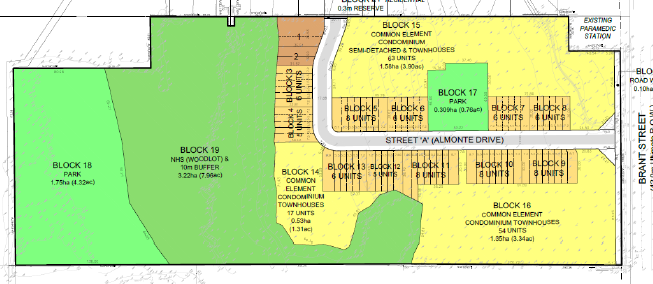 Think traffic flow onto Brant – and pity those that want to make a left hand turn on Brant in the morning rush hour.

 By Staff By Staff
April 22nd, 2020
BURLINGTON, ON
Somewhere in Germany – food is put in a plastic bag and left for people who need it.
Simple, almost elegant.
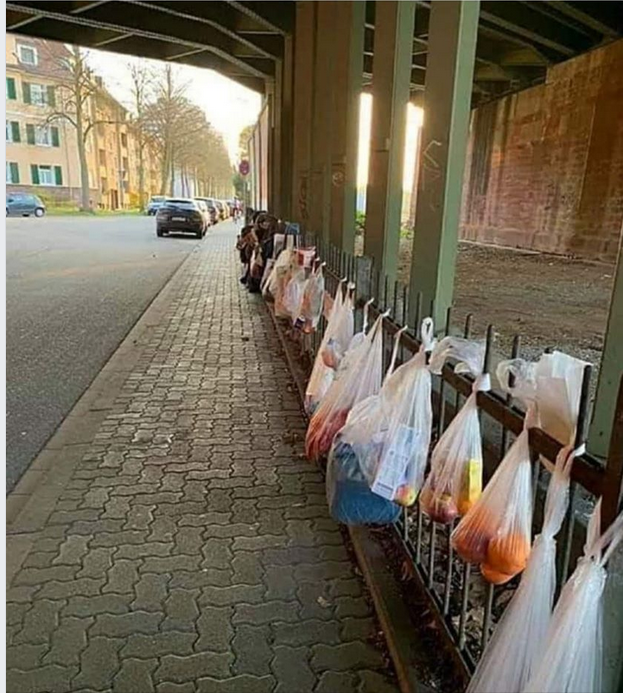 If you tried that in Burlington – it would probably be a bylaw infraction or Legal would find a way to say – that it can’t be done. If you tried that in Burlington – it would probably be a bylaw infraction or Legal would find a way to say – that it can’t be done.
Nice idea though – eh! Makes you feel good

|
|

































 “All four Mayors have made the commitment to keep each other apprised of decisions being considered in each respective municipality, share best practices, and coordinate when it comes to the recovery planning. They will also ensure a continued close linkage with Halton Region, with the chair Gary Carr as an invited guest to our group when his schedule permits.”
“All four Mayors have made the commitment to keep each other apprised of decisions being considered in each respective municipality, share best practices, and coordinate when it comes to the recovery planning. They will also ensure a continued close linkage with Halton Region, with the chair Gary Carr as an invited guest to our group when his schedule permits.”

 By Ashley Worobec
By Ashley Worobec

















 The HRPS and Halton CAS are asking that everyone remains mindful of the welfare of their neighbours, their children’s friends and classmates, and their relatives. It is crucial that residents also speak to their children about what to do if a friend confides in them that they are not safe at home.
The HRPS and Halton CAS are asking that everyone remains mindful of the welfare of their neighbours, their children’s friends and classmates, and their relatives. It is crucial that residents also speak to their children about what to do if a friend confides in them that they are not safe at home. The Burlington Foundation today announced the first round of charities that will receive $163,500 from the Covid-19 Pandemic Response Fund since the Foundation announced the fund on March 31; 17 grants were announced.
The Burlington Foundation today announced the first round of charities that will receive $163,500 from the Covid-19 Pandemic Response Fund since the Foundation announced the fund on March 31; 17 grants were announced.
 • $10,000 to Burlington Food Bank & Open Doors of St. Christopher’s to purchase fresh food and
• $10,000 to Burlington Food Bank & Open Doors of St. Christopher’s to purchase fresh food and 


 For example, in many remote regions, Facebook or Twitter might be the only free Internet access people have. And with pockets of restriction on free press, social media often represents the only outlet for “truth” for some users. There are some areas where people can receive unlimited Facebook access when they top up their mobiles. If they’re working, they’ll almost always use Facebook Messenger or another social media chat tool to stay in touch rather than drain their SMS allowance.
For example, in many remote regions, Facebook or Twitter might be the only free Internet access people have. And with pockets of restriction on free press, social media often represents the only outlet for “truth” for some users. There are some areas where people can receive unlimited Facebook access when they top up their mobiles. If they’re working, they’ll almost always use Facebook Messenger or another social media chat tool to stay in touch rather than drain their SMS allowance.





 If you tried that in Burlington – it would probably be a bylaw infraction or Legal would find a way to say – that it can’t be done.
If you tried that in Burlington – it would probably be a bylaw infraction or Legal would find a way to say – that it can’t be done.


